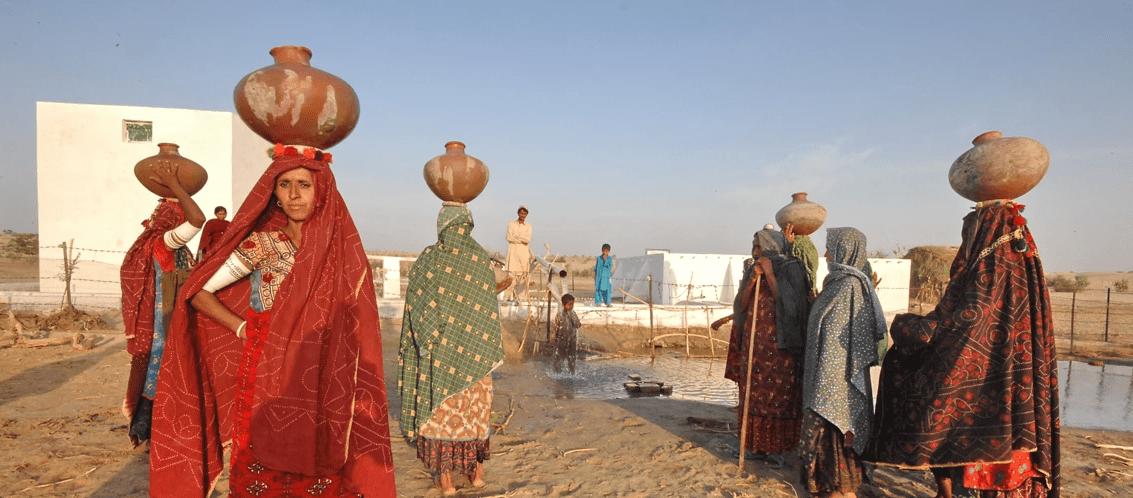
“20 feet of water flooded our village” – “Prices of everyday goods are soaring…we cannot buy enough food.” – “Children are not able to go back to school.” – “Our water is contaminated…we are suffering from diarrhea and skin diseases.”
These troubling accounts, while tragic, have become all too familiar. In just three years, Pakistan has faced the COVID-19 pandemic, the most severe locust outbreak in 30 years, a drought emergency, and unprecedented flooding that submerged a third of the country.
The “new normal” of compounding crises present an unparalleled challenge to poverty alleviation and economic growth. Families are struggling to send their children to school and put food on the table. Prior to COVID-19 and the 2022 floods, about 20.3 million children were out of school. The latest 2023 census now reveals this number is at 25.4 million.
Inflation and an economic crisis on the heels of the pandemic and floods, have rolled back gains on poverty reduction – an additional 7 million Pakistanis live below the poverty line now. 42 percent of the population lives in moderately to highly food insecure households, due to market distortions, inflation, and climate change affecting agricultural production.
The 2022 floods caused unprecedented destruction, affecting 33 million and resulting in US$16.3 billion in recovery and reconstruction needs. As one of the top 10 countries most impacted by climate change, more frequent and intense weather events are expected.
The World Bank recently supported a study on Pakistan’s Crisis Preparedness Gap Analysis in collaboration with government, development partners, non-governmental organizations, and private sector. This diagnostic is part of the World Bank’s new Crisis Preparedness and Response Toolkit, created to address the growing need for stronger crisis preparedness in a world beset with risks. The Crisis Preparedness Gap Analysis assesses and provides recommendations on the preparedness for natural hazards, food insecurity, and health emergencies, across five key components:
Legal and Institutional Foundations
Pakistan has made significant headway in the development of robust policies and plans addressing both ex-ante and ex-post crisis management. Establishing clear financing strategies, identifying financial mechanisms and sources for implementation, and establishing monitoring mechanisms to track progress of key plans, will support the operationalization of the disaster risk management framework. Updating legislation to address overlaps and gaps for roles, responsibilities, and coordination mechanisms at both national and subnational levels, is necessary.
Understanding and Monitoring Risks
The country exhibits a comprehensive understanding of its different types of hazards and risks. A critical next step is to ensure risk assessment data is accessible on a centralized digital platform and build capacities at the local government levels for their application. With climate change intensifying and weather patterns becoming more erratic, accurate forecasts and timely, impact-based early warnings are vital. Last-mile dissemination to communities through multiple channels, utilizing social media, as demonstrated in Cyclone Biparjoy, can support effective response.
Financial Preparedness
Reviewing the government’s outstanding contingent liabilities at both national and subnational levels, and identifying appropriate ex-ante and ex-post disaster risk financing instruments, is crucial. Implementation of a disaster risk financing strategy is urgently needed. A risk-layered approach, including reserve funds, credit options, insurance of public assets, and dedicated risk facilities, will strengthen Pakistan’s financial preparedness.
Primary Response
The development and streamlining of emergency financing and procurement procedures can enable rapid response in emergencies. A GIS-based national-level asset management system on critical infrastructure, along with climate resilient design and business continuity plans, will enhance the resilience of infrastructure. Such measures will help the government to continue service delivery and support families’ access to critical facilities like health care centers and schools. Strengthening local governments with dedicated disaster managers and trained personnel, —including specialized public health experts for disease outbreaks—will bolster Pakistan’s frontline response capabilities.
Social and Livelihood Support
During the COVID-19 pandemic and 2022 floods, the National Socio-Economic Registry was successfully used to rapidly identify and provide emergency cash transfers to vulnerable families. Linkages between social protection functions and crisis management can be further institutionalized for timely, shock-responsive social protection. An end-to-end framework and financing to ensure food security will support the protection of the large number of families dependent on agriculture. A coordinated focus on food security is crucial, given Pakistan’s high incidence of malnutrition and stunting. To ensure education continuity, allocation of financial, human, and infrastructural resources under the Pakistan School Safety Framework, is needed.






